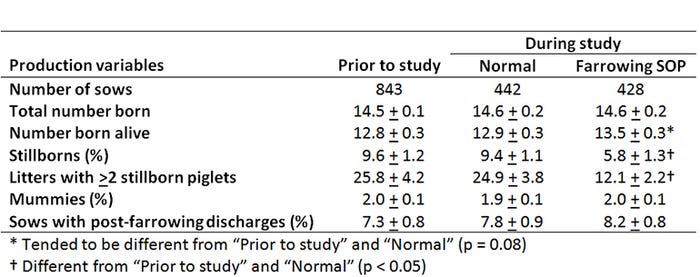Adoption of farrowing SOPs reduced the percentage of stillborn piglets per litter mainly by reducing the proportion of litters that had two or more stillborns.
October 24, 2017

By W.L. Flowers, North Carolina State University Department of Animal Science
Manually removing piglets from the sow’s birth canal during farrowing, or “sleeving”, is a management practice that both swine industry professionals and the general public view in a positive way. It helps prevent sows from becoming fatigued during farrowing. This should help them maintain the ability to initiate and successfully complete the powerful contractions needed to push piglets out.
It also decreases the likelihood that piglets are born weak, hypoxic or dead due to prolonged transit times through the uterus and cervix. However, what often is challenging for many employees is determining when to intervene versus when to leave sows alone and “let nature take its course”, so to speak.
Experienced technicians often rely on changes in behavior as a guide provided that they can observe sows frequently and be present during the entire farrowing process. On most operations, this can be difficult to accomplish in a consistent fashion due to a number of different factors.
An alternative approach would be to establish a set of guidelines or standard operating procedures with regards to which sows should be checked. While some of the guidelines listed in such an SOPs may be farm-specific there are several aspects of which should be universal and fairly easy to implement based on the physiology associated with farrowing.
For example, stillborn piglets are more likely to occur toward the end of farrowing since sows often get fatigued which reduces the strength of their contractions.
Recently, the relative effectiveness of implementing a set of “Farrowing SOPs” was evaluated on four different farms. This was done by having farrowing technicians follow a prescribed set of guidelines for checking sows in some farrowing rooms while in others a separate group of technicians managed sows according to their normal routines. The main points of the farrowing SOPs were as follows.
1. The average total number of pigs born (live born + stillborn + mummies) for each sow was written in the corner of her farrowing card.
2. Total number born was circled for any sow that had more than two stillborn pigs in her previous parity or averaged more than two stillborns per litter over all parities.
3. In the morning immediately after arrival, farrowing technicians checked any sows that were in the process of farrowing and …
a) had stillborn pigs in the farrowing crate (delivered them overnight); or
b) had a history of stillborn piglets (circled numbers) and had reached 70% or more of their average total number born (i.e: 9 piglets present for a sow that averaged 12 total born)
4. During normal working hours, farrowing barn technicians monitored sows as they normally would. The only exception was that any sow that delivered a stillborn piglet was sleeved and observed on a regular basis until she was done farrowing.
5. In the afternoon just before the farrowing technicians left work, they sleeved any sow that had reached 70% of her total number born alive and had a history of stillborn piglets.
The following table summarizes the results from the study. The second column contains average farrowing parameters for a two-month period prior to the study whereas the third and fourth columns contain these variables for the rooms without any management changes (controls) and the rooms that followed the revised farrowing SOPs (treated), respectively.

Adoption of farrowing SOPs reduced the percentage of stillborn piglets per litter mainly by reducing the proportion of litters that had two or more stillborns. This resulted in a statistical trend for an increase of 0.6 live born pigs per litter without any change in the incidence of post farrowing discharges.
Consequently, depending on the current stillborn rate within a herd, developing SOPs that concentrate on reducing sows with multiple stillborns per litter may prove to be an effective way to improve number of pigs born alive.
You May Also Like


